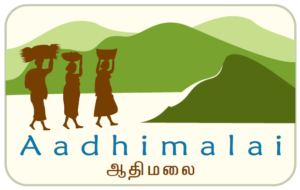
We procure honey directly from the honey hunters of the Nilgiri Biosphere Reserve. Honey is collected from the honeycombs of the Apis Dorsata or the Indian Rock Bee. It gets its name from its habit of nesting beneath overhanging rocks. It is also known as the Giant Bee and is a tropical species found throughout South East Asia and the Indian sub-continent. This indigenous bee species lives only in the wild and is harvested by tribal communities living close to forested areas.
The honey hunting season is between April to July. Honey hunting is considered a ritual by the indigenous community in the Nilgiri area. The Kurumbas, who are a major community who collect honey, perform a puja while going to look out for hives and mark hives so that others do not collect from the same hives. The hunter goes on a fast 12 days before the date of hunting.
The honey hunting is done by a team which has a lead honey hunter. He ascends the ladder to harvest the honey from the cliffs. The rope ladder in itself is made of forest vines. It is hung below from the top of a cliff or a tree.
A custom followed by the community is to have the brother of the hunter’s wife being responsible for holding the ladder in place. Five stings from a bee is enough to knock down the honey hunter, but the hunter braves these odds to collect the honey.
Other techniques to harvest honey are adopted depending on the type of local material available, height of nesting and skill required.

At Aadhimalai, we process this honey and have the following variations of honey available for external market:
– Sweet Honey: Honey has numerous health benefits and hence has found its place as a base ingredient in traditional medicine like Ayurveda and Siddha medicines. It is known to help in digestion, build immunity and have anti-bacterial properties.
– Bitter Honey: Bitter honey is sourced from Jamun tree or Naval tree. The honey is light reddish in colur and thin. The water content of this honey ranges from 21% to 26%. It has a distinguishing pungent/bitter taste. The Jamun tree is considered as possessing medicinal properties and hence the honey from this nectar source. The local tribal community uses it to cure stomach aches and disorders and toothache. Ayurveda preparations also prefer this honey.
– Spiced Honey: At Aadhimalai we have four varieties of spiced honey mixed with pepper, ginger, cinnamon and saffron. Pepper honey is known to clear throat infections, whereas ginger honey clears chest congestion. Cinnamon honey aids in weight loss and saffron honey purifies the blood.
– Honey with Dry Fruits: We have multiple varieties of honey with dry fruits which not only enhances the taste of the honey but also adds to the medicinal properties.
